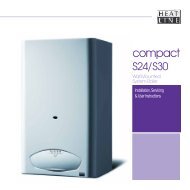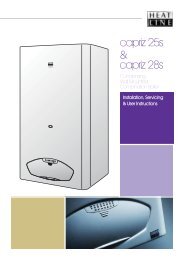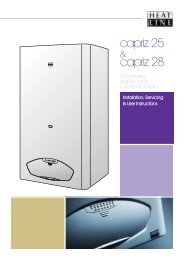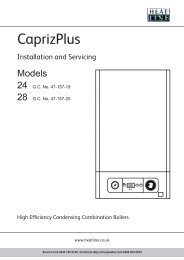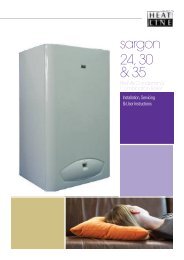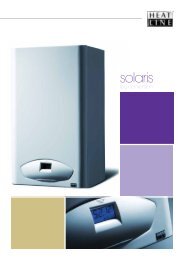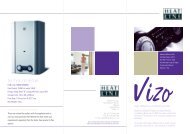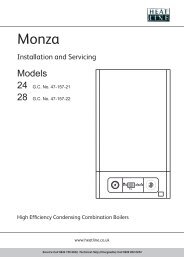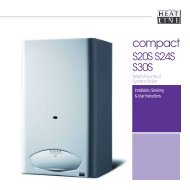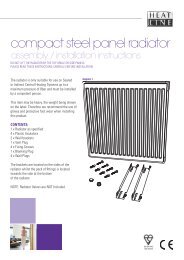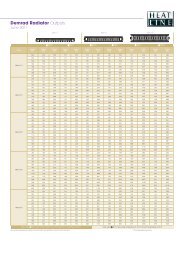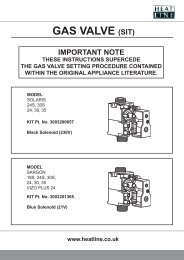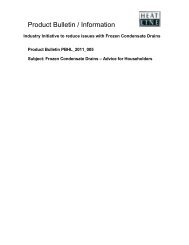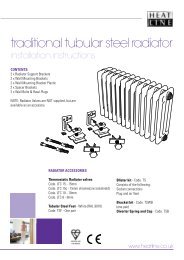solaris 24PC 30PC - Heatline
solaris 24PC 30PC - Heatline
solaris 24PC 30PC - Heatline
Create successful ePaper yourself
Turn your PDF publications into a flip-book with our unique Google optimized e-Paper software.
<strong>solaris</strong> <strong>24PC</strong>, <strong>30PC</strong><br />
11<br />
for air and where possible, the system pipe<br />
work should have a gradient to ensure any<br />
excess air is carried naturally to other purpose<br />
made, air release points.<br />
5.8 The system’s water must always be<br />
allowed to circulate whenever the circulation<br />
pump is running. A return by-pass must be<br />
provided.<br />
NOTE – It is no longer permissible to use<br />
non-thermostatic radiator valves to allow<br />
by-pass through a radiator.<br />
5.9 In high water volume systems or under<br />
floor heating systems where prolonged<br />
operation of the boiler is expected at<br />
temperatures below 60 0 C, a by-pass must be<br />
installed on the boiler outlet in order to<br />
prevent condensation forming inside the boiler<br />
body. Failure to comply with this requirement<br />
will invalidate the manufacturer’s guarantee.<br />
5.10 The pressure relief discharge must be<br />
directed away from any electrical equipment<br />
or where it could cause a hazardous situation<br />
and terminated in a safe but visible position.<br />
5.11 To enable adequate drainage of the<br />
system drain cocks compliant with BS2879<br />
must be fitted at the lowest points in the<br />
system pipe-work.<br />
5.12 To obtain the best hot water performance<br />
from your boiler it is suggested that the cold<br />
water supply to the boiler is taken directly<br />
from the incoming mains water supply.<br />
Note that the boiler will not operate unless<br />
there is a minimum pressure of 0.25bar with a<br />
flow rate of 2.5l/min. Where inlet pressures<br />
exceed 8bar, a pressure regulator must be<br />
fitted to the cold water supply.<br />
5.13 Where cold water mains are fitted with a<br />
water meter, check valve(s) or loose jumper<br />
stopcock it is recommended that a domestic<br />
hot water mini-expansion vessel may need to<br />
be fitted.<br />
5.14 Although the boiler is designed to inhibit the<br />
formation of scale, in hard water areas above<br />
200mg/l, a proprietary scale reduced should be<br />
fitted in the cold water supply to the boiler.<br />
5.15 To obtain the best hot water performance<br />
from your boiler it is suggested that supplies to<br />
faucets are run in 15mm copper, as short as<br />
possible and where practical, be insulated to<br />
reduce heat loss.<br />
5.16 The boiler incorporates a frost protection<br />
thermostat. Therefore if the boiler will not be<br />
used for long periods of time during cold weather,<br />
in order to avoid freezing the electric supply must<br />
be left ON and all the central heating isolation<br />
valves must be left open. The internal frost<br />
thermostat will then operate the boiler if the<br />
temperature falls too low. However, if the<br />
electrical supply is to be turned off the boiler, the<br />
heating system and domestic hot water circuit<br />
must be drained.<br />
6. Appliance Sitting<br />
6.1 If the boiler is to be installed in any room or<br />
compartment, it requires no purpose made<br />
ventilation for combustion air. If sited in a room<br />
containing a bath or shower then particular<br />
reference is drawn to the current I.E.E. Wiring<br />
Regulations and local Building Regulations.<br />
.<br />
6.2 The boiler is not suitable for external<br />
installation unless protected by a purpose made<br />
building such as a boiler house.<br />
6.3. The following clearances are recommended<br />
for installation purposes; 200mm above, 300mm<br />
below and 20mm at each side. 600mm is required<br />
at the front but this may be upon opening a<br />
cupboard door.<br />
6.4 The boiler must be sited at least 1m away from<br />
flammable materials and combustible walls must<br />
be protected with appropriate insulation.<br />
.<br />
6.5 The wall on which the boiler is mounted must<br />
be sufficiently strong enough to support the<br />
weight of the boiler.<br />
Page 11



